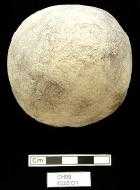Extract from:
"Clays, Clay Balls & other Clay ‘Objects’ " by Sonya Suponcic, in Catalhoyuk 1999 Archive Report (catal.arch.cam.ac.uk/archive%5Frep99/suponcic99.html)
Introduction to Clay Balls
Clay Balls are solid spherical objects made of fired or baked clay with
smooth surfaces of varying colors weighing between 1 to 900 grams with
diameters varying from 1 to 9 cm. They occur in every house excavated at
Çatalhöyük in a variety of contexts including under, in, or near ovens,
between buildings, and in refuse pits or middens. While their ubiquitous
presence in domestic contexts leaves no doubt that they were part of daily
practice, the function(s) and significance of the clay balls remains somewhat
of a puzzle. The balls had traditionally been assumed to be projectiles
or ‘sling balls’ used for hunting. However, since beginning my research
at Çatalhöyük during the 1997 field season I have been challenging this
interpretation and have been conducting research related to my major working
hypothesis – that the clay balls’ primary function was related to heat
transfer and that they would have been used in cooking and food preparation
as well as for heating rooms within houses.
Investigation of Clay Object Use
Although many theories have been advanced regarding the use of clay balls and clay objects the main working hypothesis is that these objects were used as ‘heat transfer devices’ both for various forms of cooking and food preparation and also as room warmers. According to this hypothesis, when used for food preparation and/or for heating an area of a house the clay balls would have been placed into a fire and heated for a prolonged period of time and then removed from the fire and used in any number of ways. For cooking, the balls could have been placed into a basket with some starchy plant (such as tubers) and/or meat and brought to a ‘boil’ – in essence they would have used these clay balls as ‘stone’ or ‘pot’ boilers. According to the same heat transfer idea, the clay balls may have also been used for pit cooking, in much the same way as modern Native North American Indian tribes use stones for roasting various meats and plants. If used this way, after heating the clay balls would be placed into a pit, which has been dug into the soil. Inside this pit along with the clay balls would be placed food (either plants and/or meats) and various types of moist greenery. The pit would then be covered with soil and left for 15-24 hours. After the elapsed time the heat from the balls would have slowly steamed the food making it palatable. Finally, if used to heat rooms, after being placed in the fire (presumably in a hearth located on the roof) the balls would be brought down into the room and placed in a small pit or in the interior hearth. There these heated clay balls would presumably give off enough heat to keep the small rooms warm for several hours.
Investigations into these various heat transfer hypotheses have continued
since 1997 and include organic residue analysis, heating/firing temperature
investigations, and contextual analysis of clay ball contexts. Although
numerous samples have been taken for both organic residue and firing temperature
investigations, these analyses have not yet been completed. However analysis
of the context of the clay balls to this point support the heat transfer
hypothesis. The balls are found in or near ovens and in at least one case
from the 1999 season (unit # 5004) clay ball fragments were found to line
the base of ovens, illustrating that those living at Çatalhöyük certainly
felt the usefulness of these objects as insulators and heat transfer devices.
As mentioned earlier, there were numerous pits (units 4915, 4913, 4941,
4290) found during the 1999 field season which contain both whole and fragmented
clay balls along with little else in the fill. Each pit was found in the
north central area of the room and each was close to an interior oven or
hearth. This certainly leads credence to the idea that these balls were
used in association with the oven/hearths. Unit number 5154, which is from
the north of space 170 in the south area, contained a large amount of clay
balls as well as geometrically shaped clay objects. The close association
of these clay objects with this oven, again supports the idea of these
being used for cooking or some other activity which involves the use of
the oven.
